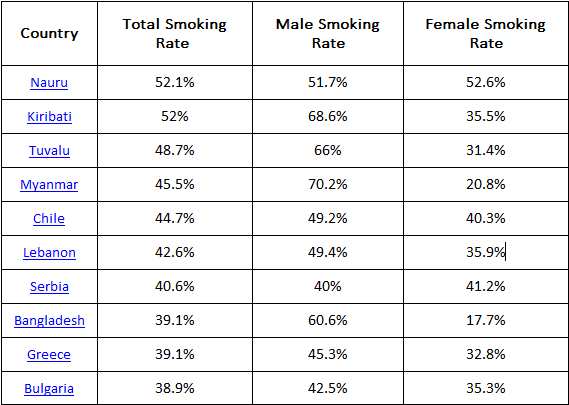
Tobacco consumption is a worldwide challenge
The tobacco epidemic is one of the biggest public health threats the world has ever faced, killing more than 8 million people a year, including around 1.2 million deaths from exposure to second-hand smoke.
• Tobacco kills more than half of its users.
• In 2020, 22.3% of the world’s population used tobacco, 36.7% of all men and 7.8% of the world’s women.
It is important to understand that all forms of tobacco are harmful, and there is no safe level of health from exposure to tobacco. Cigarette smoking is the most common form of tobacco use worldwide. Other tobacco products include: waterpipe tobacco, various smokeless tobacco products, cigars, cigarillos, roll-your-own tobacco, pipe tobacco, bidis and kreteks, and all kinds of vape and electric cigarettes.
Which countries has the most tobacco use rate?
More than 80 percent of the world’s 1.3 billion tobacco users live in low- and middle-income countries, and the highest rates of tobacco-related illness and death occur in these areas. In fact, the deviation of household expenses from basic needs such as food and shelter to tobacco is one of the factors that contribute to poverty.
The economic costs of tobacco use are substantial and include significant health care costs for treating the diseases caused by tobacco use as well as the lost human capital that results from tobacco-attributable morbidity and mortality
A look to the statistics of tobacco production in the world
Tobacco is a plant product containing mainly nicotine, cellulose, ammonia, and protein. In order for tobacco to be suitable for human consumption, the tobacco leaves are dried and cured after picking them at the plant and separating them from their stems. Various tobacco goods can be manufactured from the processed dried leaves including cigarettes, cigars, chewing tobacco, pipe tobacco, and shisha tobacco. It is predominantly consumed for the stimulant alkaloid nicotine and is associated with many heart- and lung-related diseases including cancer.
Tobacco and tobacco production is mainly concentrated in regions with a mild and sunny climate, which is suitable for the cultivation of tobacco plants. The countries that have the largest amount of tobacco production in the world are China, India and Brazil, and after them, the United States is in fourth place.
The global tobacco industry produced approximately six million tons of tobacco in 2020. China is the world’s leading producer of tobacco, accounting for more than a third of global production in 2020. Brazil and India were two other big producers. Also, the leading company in tobacco production around the world was British American Tobacco, which had about 33 billion dollars in net sales in 2020. With sales of just under $30 billion, Philip Morris International was the second largest tobacco company worldwide that year.
Which countries smoke more?
In general, the highest rate of smoking is observed in Southeast Asia and the Balkan region of Europe. Countries in Western Europe and the Americas have lower smoking rates, although Chile has one of the highest smoking rates in the world. Of the top five countries with the highest smoking rates in the world in 2018, three are in the Pacific Islands, one is in Southeast Asia, and one is in South America.
Smoking rates worldwide have decreased due to increased education about the effects of tobacco and anti-tobacco campaigns. In 2000 the smoking rate in the UK was 38%, which has fallen to 19.2%. In the table below, we can see the top ten countries in tobacco consumption:

 Idealween
Idealween